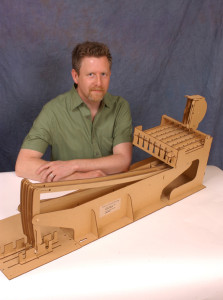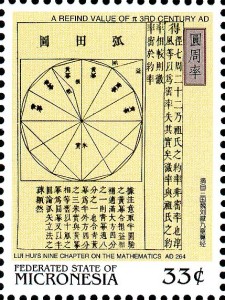Ladies and gentlemen, every now and then there comes a time when a man has gathered more maths links than he can comfortably hold on to and he is forced to loosen his grip, allowing the more wriggly ones a chance to slip away and make a break for freedom. On such occasions, the sticky surface of a specially-prepared blog post can be used to trap those links, preserving them in digital formaldehyde for closer inspection by the educated viewer.
That’s right: after literally a third of a year, I’m still Christian Perfect and here’s another Aperiodical Round Up!
 I’m going to start with computers and calculators, because here’s a really good one: Thomas Fowler’s ternary calculating machine. It uses balanced ternary arithmetic for a variety of reasons which become very interesting when you build your own calculator. Mark Glusker did build his own calculator; that’s a picture of him on the right, looking quietly satisfied with a job well done. No specimens or drawings of the original calculator exist, so Mr Glusker’s machine is only representative of his idea of how it might have looked.
I’m going to start with computers and calculators, because here’s a really good one: Thomas Fowler’s ternary calculating machine. It uses balanced ternary arithmetic for a variety of reasons which become very interesting when you build your own calculator. Mark Glusker did build his own calculator; that’s a picture of him on the right, looking quietly satisfied with a job well done. No specimens or drawings of the original calculator exist, so Mr Glusker’s machine is only representative of his idea of how it might have looked.
Ternary could have been the kind of arithmetic all computers used, had things worked out differently for ole Jonny Communist. In the 1950s, Nikolay Brusentsov created a computer based on balanced ternary arithmetic called Setun for Moscow State University. It was a mad paradigms double-whammy: the programming language created for it, DSSP, used Reverse Polish Notation. Some nostalgic/patriotic/quixotic Russians have made a charming online simulator of Setun, complete with all the right flippy-switches and terse, efficient Cyrillic labels. I don’t think anyone will knock on your door if you get it to repeat “DOWN WITH STALIN” in an infinite loop, though; if we’ve learned anything in the last two paragraphs, it’s that the authenticity of historical replicas is by necessity limited.
All this talk of ternary arithmetic and Soviet switch-waggling can confuse a chap. Time was, one could perform any calculation desired of one with a simple tool not mechanically dissimilar to a swanee. Derek’s Virtual Slide Rule Gallery lets you relive that simpler time, with a selection of lovingly recreated instruments which can be slid and ruled to your heart’s content. Derek, I salute you!
Did you know that the card game Magic: The Gathering is Turing-complete? Add it to the long, long list of unexpectedly compute-able objects, somewhere near the bottom: it adds to the requirement for infinite resources a requirement for three infinitely patient friends. This never-ending quest that humanity seems to have taken on to find all the Turing-complete objects is beginning to look less like inventive collation of disparate ideas and more like stamp collecting.
 Stamp collecting is a hobby to some, and a disdainful term for uninventive enquiry to others. Why not combine the two? Actually, I’m underselling this. Jeff Miller’s page Images of Mathematicians on Postage Stamps is an enormously extensive collection of probably every stamp featuring the face of a mathematician that has ever been printed. There’s an additional section at the end for stamps on other mathematical topics. Why Turkey ever felt the need to issue a stamp promoting the feat of subtraction might remain a mystery to me until my final day.
Stamp collecting is a hobby to some, and a disdainful term for uninventive enquiry to others. Why not combine the two? Actually, I’m underselling this. Jeff Miller’s page Images of Mathematicians on Postage Stamps is an enormously extensive collection of probably every stamp featuring the face of a mathematician that has ever been printed. There’s an additional section at the end for stamps on other mathematical topics. Why Turkey ever felt the need to issue a stamp promoting the feat of subtraction might remain a mystery to me until my final day.
The first name in James’s list is Niels Henrik Abel’s. Did you know there’s an awesome statue of Abel in the Palace Park in Oslo? I didn’t before, but now I do. The Math Places blog has its coordinates, as well as those of a few other statues, gravestones and architectural features commemorating sundry other mathematicians.
“Stamp collecting” can refer to any activity involving collecting lots of the same type of thing. Robert Browning Sosman engaged in some scientifico-culinary stamp collecting in the 1930s to create his Gustavademecum, an indulgently geek-amenable restaurant guide “prepared for the convenience of mathematicians, physicists, engineers, and explorers”. Sosman made it his job to visit every restaurant in New York, collecting data on the kind of food served, typical prices, and his opinions on the qualities of the food, the staff and his fellow patrons. Rather than writing up his experiences in pithy essays like a journeyman critic, Sosman did what a scientist does and quantified and tabulated his data, so that the reader might draw his own conclusions using whatever metric he desires. The book glories in its nerdishness: in the “other descriptive data” column, an eccentric selection of symbols, mainly Greek letters, is employed to denote the presence of amenities such as an ice skating rink (Σ), a samba band (σ) or a piano (Mπ). I would love to own a copy.
One of the great feats of mathematical stamp collecting of recent years was the classification of the finite simple groups. The collected proof of the classification is beyond any single human brain, but the results are accessible to anyone. They’re even more accessible now, thanks to this handy Periodic Table of Finite Simple Groups drawn up by Ivan Andrus. It collects all the families of finite simple groups into a rather fetching table, arranged and colour-coded by properties and featuring helpful data such as the mind-bogglingly huge orders of some of the groups.
¡Let’s talk about ! Polyhedra ! now!
Or before we do that, I’ll explain the explosive appearance of the previous sentence: ! Polyhedra ! is a Flickr user who collects lots and lots of picture of origami polyhedra. I was swept along by their enthusiasm for polyhedra and thought I’d join in with some peppy punctuation of my own.
If you feel similarly strongly about polyhedra — so strongly that you’d like to share your appreciation with others — you might like to form a club and hold meetings in your very own icosahedral club house, made from the humblest of construction materials: rolled-up newspapers and a few staples.
A clubhouse is an ideal location to play a family-friendly board game. Might I suggest Spinpossible? Alex and Andrew Sutherland reckon it holds up well to mathematical analysis. If that doesn’t hold your interest, you can pass the time playing MilkSnake, a snake game on non-euclidean surfaces.
Hey, what’s yellow and equivalent to the axiom of choice? Zorn’s lemon. What’s a bit up itself but oddly captivating? ZORNS LEMMA.
[youtube url=http://www.youtube.com/watch?v=8VlT0D3vFmc]
ZORNS LEMMA is an experimental film made in 1970 by Hollis Frampton. I’m not sure why it’s called that.
The etymology of Back TUVA Future is a lot easier to discern. It’s a track by Tuvan throat-singing master Ondar, intermingled with clips of superstar scientist Richard Feynman laying down his own sweet raps on the subject of not too much at all.
[youtube url=http://www.youtube.com/watch?v=2uf1lEawgTE]
Thanks to this little gem of a record, Richard Feynman acquired an Erdős-Bacon-Sabbath number of 10.
Maths is quite an old subject. Dudes were thinking up theorems and doodling diagrams well before the invention of things that are today considered indispensable, like clothing that doesn’t have a winding number and responsible library archival policy. Chiefly because of the latter (and possibly because of the former – who knows how many great thoughts had to be thrown away for want of a breast pocket), the thoughts of the Ancients aren’t too well known to today’s student. I’ve found three people who want to fix that.
First, S.G. Dani writing for The Hindu seeks to help us understand Ancient Indian mathematics. Probably less helpfully, Messrs. Arcara and Peters of the Classical Liberal Arts Academy have revived the Quadrivium, so that your child can experience the same program of education that served generations of young scholars so well before the invention of such wicked modern constructs as algebra and place-value notation.
Back when the quadrivium was quotidian, it was natural for the brightest young scholars to be sent up at the end of their preparatory studies to a seat of higher learning. There they would continue their solemn study of the Classics until some outside factor such as marriage, political office or the Plague carried them away.
Today’s Oxonians, freed of the life-sapping chores of rote memorisation and toga-wrapping, seem to have a surfeit of spare time. Some of that time has been reassigned to the Oxford mathematical cake seminar. It does what it says on the tin ((do! you! see! what! I! did‽))- each week, Oxford maths students take turns to bake cakes. The usual suspects are represented, but one cake really sets itself apart: Alessandro Sisto and Rob Clancy’s trefoil knot complement cake. It’s a feast for the mind.
Finally, I have a puzzle for you. The Magic 11-cell is a Rubik’s cube-a-like which takes place on a four-dimensional polytope. It’ll probably take you a while to solve it, if that’s what you decide to do. I can’t even begin to play with it, thanks to my hue-agnostic eyes, but I trust it’s a real puzzle and not just an arbitrary shape-jumbling mechanism. I can’t be completely sure though.
Until next time!